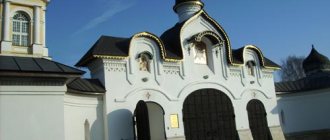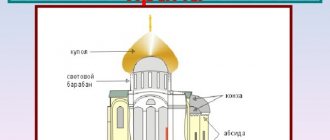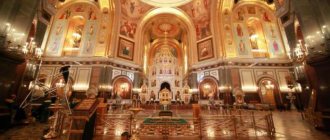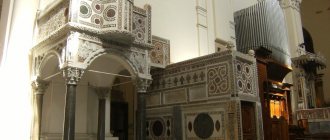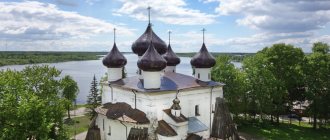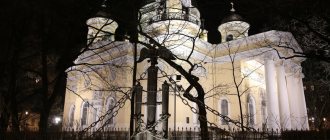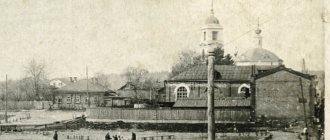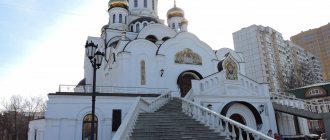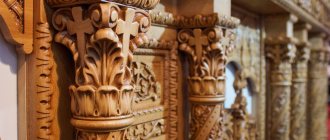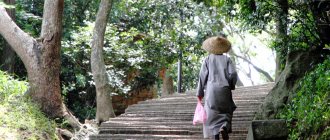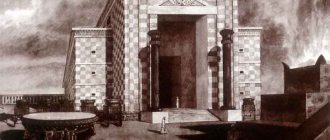Altar in the temple and throne
As we have already said, the throne is the only, in fact, obligatory part for the temple, since for the sake of the Throne and around it the temple is built. The consecrated altar itself makes the room a temple. In the place where the Throne is, a person himself should rejoice and tremble - in memory of the boundless Love of God and His earthly path.
In the first centuries of Christianity, tombs containing the relics and remains of saints or martyrs served as altars. Now this tradition has been preserved, but has changed: in the altars of churches there are no coffins, but still the throne must be consecrated by the ruling bishop and have a reliquary with a particle of the relics of some saint. Only in this case can the Liturgy be celebrated on the Throne!
The presence of the Throne implies that there is also an altar - the holy of holies of any temple. According to tradition, only temple servants can enter the altar, or with the blessing of the abbot.
Patriarchal service. photo: patriarchia.ru
What should be in the temple
In short, there is only one mandatory requirement in the way the temple is structured. Or rather, this is not even a requirement, but precisely for the sake of which the entire temple is erected: the Throne in the altar on which the Liturgy is celebrated. If there is no throne, then it is a chapel.
Everything else that we see and are accustomed to seeing in the temple is either self-evident things, or things that have developed over centuries and become a tradition.
For example, icons in a temple are a given. A temple will not cease to be a temple if there are no icons in it, but it would be strange to invest in the construction of a church and not place icons in it. It’s strange for a Christian to generally avoid icons, so any Orthodox church will have icons. And the more there are, the better: it means there will be more prayerful memory of the saints before the eyes of people.
The same thing is the cross on the temple. Liturgies were served in destroyed churches, in caves, and simply in conditions when Christians were not allowed to preach (for example, during the Muslim yoke). But when there are no prohibitions, it is strange not to proclaim with a cross on the roof of a building that this is a temple, the Holy Spirit is here, the Liturgy is here. That's why there are crosses above all Orthodox churches.
“Traditional” things can include what we are accustomed to specifically - in the Russian Orthodox Church - but in other countries the same thing may have completely different forms or be completely absent. For example, temple architecture. Or the presence of an iconostasis in the form of a “solid wall”. Or candlesticks near icons.
We will definitely talk about the architecture of churches separately, but in this text: about how an Orthodox church is arranged inside.
Iconostasis in the temple
The iconostasis separates the altar from the rest of the temple. This is not a “rule” or a canon - a temple will not cease to be a temple without an iconostasis, but it is a natural and, probably, the only opportunity to protect the Holy of Holies from worldly everyday vanity and behavior unworthy of the shrine - for example, a tourist in shorts and with a camera, behaving in a -in-laws.
In fact, this is a reasonable tradition that has become “mandatory”.
In fact, the task of the iconostasis is not so much to separate the altar as to serve people as a “window to heaven” and as a prayer aid. So that the parishioners, in the end, do not get distracted and do not pay undue attention to those actions in the altar, which, unlike the Sacraments, do not need to be given attention. For example, the priest explains to the young altar server at what moment to leave the altar with the candles: this is an absolutely “working” moment that will captivate the parishioners in a completely unnecessary way.
Temples without iconostases are found only in exceptional cases - if the temple is just being built or arranged in “camping” (temporary) conditions.
Most often in our Orthodox churches it is a “solid wall” with icons - that is, it completely hides the altar, and you can see “what is there” only at those moments of the service when the gates are open. Therefore, in large churches or cathedrals, the iconostasis can be as tall as a multi-story building: it is majestic and beautiful. Such iconostases are decorated with several rows of icons depicting the apostles, the main Church Feasts, the Savior, the Mother of God...
Iconostasis of the Trinity Church of the Moscow Compound of the Holy Trinity Sergius Lavra. Photo: blagoslovenie.su
But in some churches the design is simpler: the iconostasis does not completely hide the altar and behind it you can see both the clergy and the Throne itself. The idea of such iconostases is, on the one hand, to enclose the Holy of Holies, but on the other, not to separate the parishioners of the Great Sacrament: so that the Liturgy is not only intimate and majestic, but also a common action for the entire Community.
Icons in the temple
Icon from the iconostasis in the Georgian Cathedral in Mtskheta
An Orthodox church cannot be imagined without icons. Even the poorest rural church tries to have plenty of them - even in “printed” form.
Icons - that is, images of saints and Church holidays painted according to special rules - are present in churches in the following forms:
- Icons on the walls.
These are the icons that, so to speak, are most accessible to parishioners. They are applied to them, candles are placed in front of them. - Temple painting
(frescoes). - Icons on the iconostasis.
- Icons taken out on occasion
(for example, icons of saints that are placed in the center of the temple on the lectern on the days of the corresponding holidays). The point is not that these icons are hidden somewhere in order to give “access” to them once or twice a year, but that the space of the temple is limited and there is simply not enough space for all the icons.
Icon of the Holiday on the lectern. Photo: blagoslovenie.su
free jokes
EXTERIOR DESCRIPTION OF THE TEMPLE OF THE ANNOUNCEMENT
The Annunciation Church at the Harbin courtyard of the Russian Ecclesiastical Mission, which began construction in 1930, is made in a modernized Byzantine style according to the design of the civil. engineer B. M. Tusanovsky.
The modernized Byzantine style or “Tonovshchina” belongs to the engineer Ton, a contemporary of the reign of the Sovereign Emperor Nicholas I, who was close to the court and enjoyed the favor of the Sovereign.
According to the Highest approval, Tone's style spread throughout Russia at that time and represented a modified Byzantine style in the refraction of Tone's understanding.
This style did not catch on and was almost not practiced later, because the Russian style of Novgorod, Pskov, Vladimir-Suzdal, Kiev, etc., with numerous chapters, nevertheless turned out to be closer to the heart of the Russian person.
At its base, the Annunciation Church has a cross that is greatly elongated along its length.
The main feature of this temple is the extraordinary impression of spaciousness inside, as the structure of this temple does not have the usual pillars or pylons to support the dome.
In this case, the light drum and the dome are placed on intersecting arches, which completely frees the interior of the temple from any supports.
This method was first used by citizens. Eng. Kosyakov, as discussed above.
EXTERNAL DESCRIPTION OF THE TEMPLE
When you walk along Kitaiskaya Street, heading towards the river. Sungari, and approach Police Street, then first from behind the tall buildings you can see the bell tower of the temple with a massive gilded cross, and then the domed cross and immediately the temple, and too close, which makes it difficult to create an impression.
The view of the temple is much better from the corner of Novogorodnyaya and Politseiskaya streets, from where the temple is visible from the south-eastern corner, but the base of the bell tower is hidden behind the temple, so only the belfry itself is visible, and the integrity of the impression is lost.
The temple is very clearly visible from the corner of Artilleriyskaya and Police streets, as you approach Kitayskaya.
When describing this, this is the best place for observation, because it creates a whole impression that increases with gradual approach, which cannot be the case from the corner of Kitayskaya.
From the chosen observation point, the temple is visible from the southwest corner.
What especially stands out is the massive pediment arch on each side with two-tiered paired columns, significantly moved forward, due to which the three windows located between them fall into the shadow of the arch, which looks especially beautiful in photographs.
In the center of the arch vault there is a place for the icon.
The arch is topped with a massive cross in keeping with the massive style of the temple.
The huge dome rests on the intersections of four arches.
The dome lantern with 20 windows and the bell tower with dormer windows, made up of paired columns to match the arches, emphasize the overall mass of the building.
Rounded lines and soft ovals of domes, arches, windows and doors smooth out the heaviness of the building, creating a silhouette that is pleasing to the eye. Relief ornaments running along the arches and relief patterns located above the windows, doors and along the walls of the temple enliven the surface of the stone and give a beautiful light and shadow, emphasizing the light background of the walls, which is especially well perceived by the camera.
The gate, with its rounded lines and massive patterns, complements the style of the temple, and the iron lattice, interrupted by stone pillars, serves as an excellent complement to it.
The temple is especially clearly visible from the opposite northern side, when you are sailing along the river. Sungari.
Beautiful and majestic, it stands out for its massiveness and whiteness among the surrounding buildings.
The south side has three apses extending far forward.
Along the cornice it is decorated with small arches. The crosses are striking, striking in their massive design and also in their large size, compared to other Harbin churches.
According to Orthodox custom, the cross rests on a ball depicting the universe, like the foot of St. cross.
The cross of the bell tower is visible from afar from the lower and upper reaches of the river.
As soon as you approach the gate, the tightness is immediately noticeable.
The proximity of the old temple and the house located near the gate creates the impression of a clutter of buildings, due to which the general appearance of the temple is lost.
Majestic in area and in thought, beautiful in architecture and decoration, the temple loses a lot due to the lack of area around it, proportional to its size.
Due to lack of space, the main porch of the central porch has a truncated appearance and a steep rise.
But the side porch of the central porch is significantly increased in area with low and wide steps, and this smoothes out the shortcomings of the main porch, but it breaks the symmetry of the porch, which would not be the case with the same porch on the left side, which the lack of space does not allow.
The best view is from the southern porch, located along the façade of Police Street. and given its location, it occupies a central place.
The porch area is large, the staircase is gentle with low and gentle steps, which creates an overall good view and convenience for those entering.
In the porch on the north side of the porch, due to its proximity to the old temple, the same truncation is felt, and the three porches located on both sides of the porch, although caused by practical considerations, still spoil the appearance of the north side of the temple.
At the same time, seven porches, located on different sides of the temple and made of different types, disrupt the overall impression, disrupting the unity in the building.
This is what you see when examining the temple from the outside.
Kliros, what is this?
The choir in the temple is a place for the choir. Most often it is located on the side in the front part - near the iconostasis on the side. In some churches - at the back wall opposite the iconostasis (for example, on the balcony above).
All choirs have, perhaps, one thing in common: they try to make the singers invisible to the parishioners so that neither one nor the other is distracted. For example, if the choir in a church is located in front of the iconostasis, it is separated by a partition. And if the choir sings on the balcony near the “back wall”, then it is not visible anyway.
Choir during the patriarchal service. Photo: patriarchia.ru
